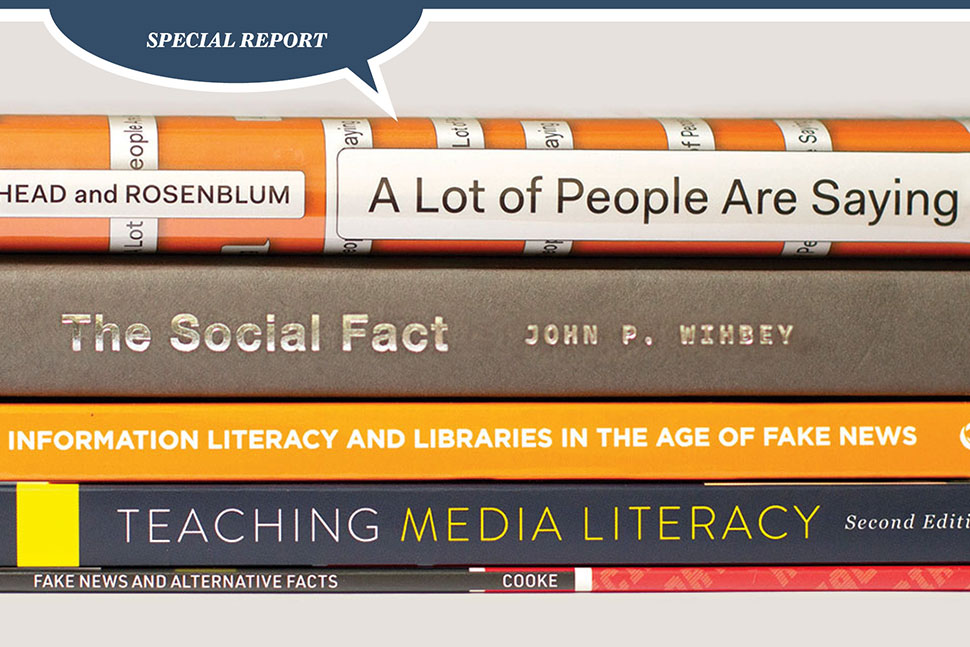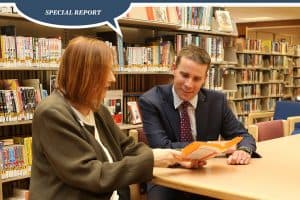
After several years of fake news and alternative facts, media literacy is still a challenge. The 2018 Learning and Prototyping Report showed that news consumers think they are better at media literacy than they actually are. How can libraries help bridge that gap and help their communities get informed?
Librarians can ensure patrons make informed decisions in local, state, and national elections by helping them think critically. Libraries of all types can promote media literacy by providing handouts, LibGuides, training, and programs about separating fact from online fiction. The following resources can assist.
The National Association for Media Literacy Education, a nonprofit organization based in New York City, defines media literacy as the “ability to access, analyze, evaluate, create, and act using all forms of communication,” including “technologies that we haven’t even dreamed of yet.” It provides guides for educators and parents, lesson plans, and election resources. The California-based Center for Media Literacy offers a MediaLit Kit to help educators create media literacy instruction programs across disciplines and grade levels.
Americans tend to label statements they agree with as factual and those they disagree with as opinion.
Between 2017 and 2018, the American Library Association (ALA) partnered with the Center for News Literacy (CNL) at Stony Brook (N.Y.) University School of Journalism on “Media Literacy at Your Library,” a pilot program that trained library workers to help adults become better news consumers. The previously mentioned Learning and Prototyping Report describes how five public libraries across the US used CNL’s media literacy curriculum to develop public programs tailored to their communities. Among those libraries’ discoveries: Young and marginalized audiences were the most difficult to reach, and future efforts could be more effective if programs were hosted in spaces more accessible to those audiences.
Although the program has ended, ALA’s Public Programs Office has received a $249,378 National Leadership Grant from the Institute of Museum and Library Services to convene a group of librarians, educators, and journalists that will design a practitioner’s guide for media literacy education. More details will emerge by the end of the year.
A cornucopia of courses
In July, the RAND Corporation released a survey on the effectiveness of media literacy training in K–12 classrooms, Exploring Media Literacy Education As a Tool for Mitigating Truth Decay. Researchers found that media literacy competencies are inconsistently defined and evaluated across disciplines, making it difficult to assess outcomes. However, the survey does offer a separate appendix in a ZIP file with a comprehensive list of courses, programs, and other resources, arranged by institution.
One open access course—developed by University of Washington biologist Carl Bergstrom and information scientist Jevin West—has received national attention. Titled “Calling Bullshit,” the course offers a syllabus, videos, tools, case studies, and a FAQ for educators who wish to adapt it. Bergstrom and West define “bullshit” as “language, statistical figures, data graphics, and other forms of presentation intended to persuade by impressing and overwhelming a reader or listener, with a blatant disregard for truth and logical coherence.”
At the heart of all media literacy education is the goal of helping children, teens, and adults recognize misleading claims online and in other media. Although often termed fake news, misinformation can take many forms. In 2016, Assistant Professor of Media Studies Melissa Zimdars of Merrimack College in North Andover, Massachusetts, and coauthor of Fake News: Understanding Media and Misinformation in the Digital Age (MIT Press, 2020), identified for her students numerous categories of websites containing suspicious information, among them sources that:
- purposely fabricate information or distort news
- present opinions as fact
- rely on disproven conspiracy theories
- traffic in unverified claims
- consist of state-sponsored propaganda
- promote racism, misogyny, or homophobia
- use exaggerated or misleading headlines or images as clickbait
A 2018 Pew Research Center survey indicates that Americans tend to label statements they agree with as factual and those they disagree with as opinion. A 2019 study by Ohio State University psychologists suggests that people do draw a distinction between dishonest and biased sources. The researchers found that even accurate news, when reported by a source considered biased, tends to lose its credibility.
Misinformation detection
One widely used source for detecting bias, “How to Spot Fake News” by Eugene Kiely and Lori Robertson, was published in November 2016 by FactCheck.org, a project of the Annenberg Public Policy Center. An infographic from the International Federation of Library Associations and Institutions (free in multiple languages) summarizes the eight techniques mentioned in the article for assessing news sources. In 2016, Finland became one of the first European countries to have its educational system formally emphasize critical thinking and the ability to recognize disinformation.
Misleading information is often difficult to counter because viral memes frequently get translated into other languages, cross national boundaries, and jump platforms, according to Daniel Funke, a writer for the journalism website Poynter. Information scientists at Indiana University Bloomington in 2017 verified that social bots and algorithms were responsible for spreading viral stories—some fake, others real—through Twitter.
Complicating things further, allegations of conspiracy no longer rely on actual conspiracy theory. Russell Muirhead and Nancy L. Rosenblum write in A Lot of People Are Saying (Princeton University, April) that factual explanations have been replaced by innuendo: “There is no punctilious demand for proofs, no exhaustive amassing of evidence, no dots revealed to form a pattern.” Instead, what passes for authority is the statement that “a lot of people are saying” something.
A good overview on fake news for librarians is Joanna M. Burkhardt’s “Combating Fake News in the Digital Age,” Library Technology Reports, vol. 53, no. 8 (Nov/Dec 2017). Burkhardt, who frequently lectures on media literacy, presents a short history of fake news starting with the Roman Empire, explains how misinformation spreads, and suggests proactive methods that librarians can use to help students navigate the information universe. Burkhardt is also the author of Teaching Information Literacy Reframed (ALA Neal-Schuman, 2016), which uses the Framework for Information Literacy for Higher Education as a tool for designing classroom exercises in media and other literacies.
Nicole A. Cooke, in the ALA special report Fake News and Alternative Facts (ALA Editions, 2018), provides tips for creating a lesson plan to help college students and adult patrons evaluate media. Belinha S. De Abreu’s second edition of Teaching Media Literacy (ALA Neal-Schuman, 2019) brings together 15 librarians and teachers to comment on media and digital literacy issues. She also offers six ready-to-teach lessons, a glossary, and a timeline of media literacy milestones. Information Literacy and Libraries in the Age of Fake News, edited by Denise E. Agosto (Libraries Unlimited, 2018), is another excellent roundup of media history and research on combating misinformation.
Finally, those interested in the historical roots of the current contentious political climate can read “The Lie Factory: How Politics Became a Business,” by historian Jill Lepore, in the September 24, 2012, issue of The New Yorker. Lepore writes about Clem Whitaker, Leone Baxter, and their consulting group Campaigns Inc., which they launched in the 1930s. “Whitaker and Baxter weren’t just inventing new techniques; they were writing a rule book,” she argues. That rule book, outlined in Whitaker’s speech before the Los Angeles Chapter of the Public Relations Society of America on July 13, 1948, contains advice that has become commonplace in 21st-century political campaigns—including “make it personal,” “pretend that you are the Voice of the People,” “attack, attack, attack,” and “say the same thing over and over again.”



